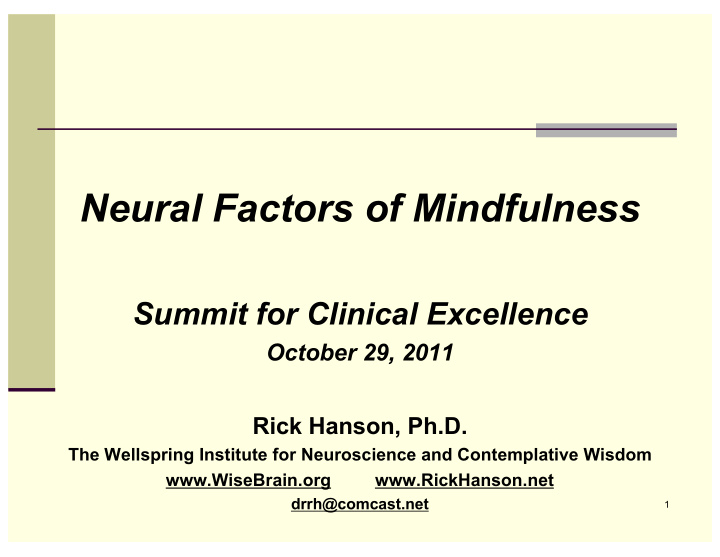



Neural Factors of Mindfulness Summit for Clinical Excellence October 29, 2011 Rick Hanson, Ph.D. The Wellspring Institute for Neuroscience and Contemplative Wisdom www.WiseBrain.org www.RickHanson.net drrh@comcast.net 1
Topics The power of mindfulness Challenges to a steady mind Neural factors of mindfulness Lateral networks of spacious awareness 2
The Power of Mindfulness 3
The Power of Mindfulness Attention is like a spotlight, illuminating what it rests upon. Because neuroplasticity is heightened for what’s in the field of focused awareness, attention is also like a vacuum cleaner, sucking its contents into the brain. Directing attention skillfully is therefore a fundamental way to shape the brain - and one’s life over time. The education of attention would be an education par excellence. William James 4
Distinctions . . . Awareness is the field in which neural activity (mysteriously) becomes conscious experience. Attention is a heightened focus - a spotlight - on a particular content of awareness. Mindfulness is sustained attentiveness, typically with a metacognitive awareness of being aware. Concentration is deep absorption in an object of attention - sometimes to the point of non-ordinary states of consciousness. 5
Being with, Releasing, Replacing There are three phases of psychological healing and personal growth (and spiritual practice): Be mindful of, release, replace. Let be, let go, let in. Mindfulness is key to the second and third phase, sometimes curative on its own, and always beneficial in strengthening its neural substrates. But often it is not enough by itself. And sometimes you need to skip to the third phase to build resources for mindfulness. 6
Challenges to a Steady Mind 7
Challenges to a Steady Mind We evolved continually scanning, shifting, wide focus attention in order to survive: “monkey mind.” This general tendency varies due to the adaptive value of neurological diversity in temperament, from “turtles” to “jackrabbits.” Life experiences - in particular, painful or traumatic ones - can heighten vigilance and distractibility. Modern culture - with its fire hose of information and routine multi-tasking - leads to stimulation-hunger 8 and divided attention.
How the Brain Pays Attention Key functions: Holding onto information Updating awareness Seeking stimulation Key mechanisms: Dopamine and the gate to awareness The basal ganglia stimostat 9
Individual Differences in Attention Holding Updating Seeking Information Awareness Stimulation High Obsession Porous filters Hyperactive Over-focusing Distractible Thrill-seeking Overload Mod Concentrates Flexible Enthusiastic Divides attention Assimilation Adaptive Accommodation Low Fatigues w/Conc. Fixed views Stuck in a rut Small WM Oblivious Apathetic Low learning Lethargic 10
Thus the importance of training the mind - and thus the brain - over time to become increasingly mindful. 11
Neural Factors of Mindfulness 12
Basics of Meditation Relax Posture that is comfortable and alert Simple good will toward yourself Awareness of your body Focus on something to steady your attention Accepting whatever passes through awareness, not resisting it or chasing it Gently settling into peaceful well-being 13
Some Neural Factors of Mindfulness Setting an intention - “top-down” frontal, “bottom-up” limbic Relaxing the body - parasympathetic nervous system Feeling cared about - social engagement system Feeling safer - inhibits amygdala/ hippocampus alarms Encouraging positive emotion - dopamine, norepinephrine Absorbing the benefits - positive implicit memories 14
Lateral Networks of Mindful Awareness 15
Dual Modes “Doing” “Being” Mainly representational Mainly sensory Much verbal activity Little verbal activity Abstract Concrete Future- or past-focused Now-focused Goal-directed Nothing to do, nowhere to go Sense of craving Sense of peace Personal, self-oriented perspective Impersonal, 3 rd person perspective Focal view Panoramic view Firm beliefs Uncertainty, not-knowing Evaluative Nonjudgmental Lost in thought, mind wandering Mindful presence Reverberation and recursion Immediate and transient Tightly connected experiences Loosely connected experiences Prominent self-as-object Minimal or no self-as-object Prominent self-as-subject Minimal or no self-as-subject 16
Increased Medial PFC Activation Related to Self-Referencing Thought Gusnard D. A., et.al. 2001. PNAS , 98:4259-4264 17
Cortical Midline Areas for Self-Referencing Thought Farb, et al. 2007. Social Cognitive Affective Neuroscience , 2:313-322 18
Self-Focused (blue) and Open Awareness (red) Conditions (in the novice, pre MT group) 19 Farb, et al. 2007. Social Cognitive Affective Neuroscience , 2:313-322
Self-Focused (blue) and Open Awareness (red) Conditions (following 8 weeks of MT) 20 Farb, et al. 2007. Social Cognitive Affective Neuroscience , 2:313-322
Ways to Activate Lateral Networks Relax Focus on bare sensations and perceptions Sense the body as a whole Take a panoramic, “bird’s-eye” view Engage “don’t-know mind ”; release judgments Don’t try to connect mental contents together Let experience flow, staying here now Relax the sense of “I, me, and mine” 21
Whole Body Awareness Sense the breath in one area (e.g., chest, upper lip) Sense the breath as a whole: one gestalt, percept Sense the body as a whole, a whole body breathing Sense experience as a whole: sensations, sounds, thoughts . . . all arising together as one unified thing It’s natural for this sense of the whole to be present for a second or two, then crumble; just open up to it again and again. 22
Panoramic Awareness Recall a bird’s-eye view (e.g., mountain, airplane) Be aware of sounds coming and going in an open space of awareness, without any edges: boundless Open to other contents of mind, coming and going like clouds moving across the sky. Pleasant or unpleasant, no matter: just more clouds No cloud ever harms or taints the sky. 23
Trust in awareness, in being awake, rather than in transient and unstable conditions. Ajahn Sumedho 24
Where to Find Rick Hanson Online http://www.youtube.com/BuddhasBrain http://www.facebook.com/BuddhasBrain w www.RickHanson.net www.WiseBrain.org 25 25
Recommend
More recommend